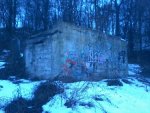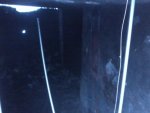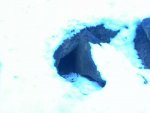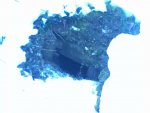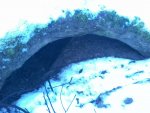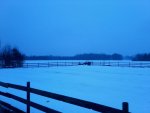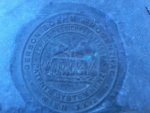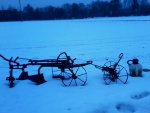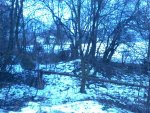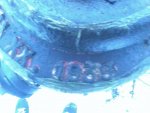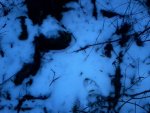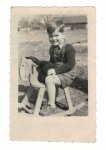Meine Erinerrung von Lager Wegscheid (aber in Englisch)
Refugee Camp In Austria
“There is nothing more dismal than a refugee camp in winter. Running water may be thirty yards away through ice and mud, with washing in a communal shack increasing the danger of pneumonia. In Europe there are still 120 camps like this one at Kapfenberg, Austria.” [1959] [note from the Internet]
A melting pot of nationalities lived in the barracks of Lager Wegscheid, Austria after World War II. There were about 100 barracks accommodating the “Fluchlingen” or DP s (aka displaced persons) who left Romania, Hungary and Yugoslavia, moving west away from the Communist armies. A camp of barracks was called a “Lager”. It seems my parents moved from Lager to Lager but that was the nature of refugees in those days.
My birth certificate, “Geburtsurkunde”, had to be reissued on July 5, 1952. It records that Johann Iwan Hartig was born in Lager Asten Nr. 100 on Feb. 23, 1946. It further states that both Rosa and Michael Hartig lived in Lager Haid Nr. 121 at the time of the issuance on July 5, 1952. Dad is described as a “Friseur” (barber) and that he is Protestant. Mom is described as “Haushalttatig”, a house-wife and Roman Catholic. It would have been shortly after the re-issuance of my birth certificate, that we would have moved to Lager Wegscheid where all my Austrian memories reside as a little boy. My half-sister, Newenka, would have had to move with mom and dad (even though dad wasn't her biological father) because, she was still a minor, a young teenager at the time.
Mom and dad were lucky to get a roof over their heads, especially after fleeing from Romania and from Yugoslavia as German speaking people when the Russian army rolled west at the end of the war. Old abandoned army barracks were a perfect blessing for “Fluchlingen” once the soldiers moved out of them after 1945/46. A refugee camp was a haven for displaced persons. However, there was also the other kind of “camp”, still fresh in people's minds in 1946, the year of my birth. The concentration camp, Matthausen, was half an hour's drive away from where I lived in Wegscheid near Linz. The Nazis were still incinerating people there only 6 months before I was born.
Well, thank goodness Wegscheid was a camp for refugees and not a concentration camp. It was a welcome refuge for displaced people, so they had a roof over their heads and so they could recover and begin new lives. However, we still had our hardships in those after the war refugee camps. There were lots of health problems and winters, especially, were very hard on people. I remember having high fevers to the point of delirium there in Austria, pin worms that mom pocked out with her fingers inside my bum (I was only 4 or 5). I had the mumps when I was 7 and had to wear a sling around my head andswollen cheek. Before my childhood memories really kicked in, when I was 2, I guess, I had also been sent to a sanatorium in Linz because of tuberculosis. I was in there for 2 years mom told me. She'd come and visit and could hear me way down the hallway, lowing like a forlorn calf with a deep and rough voice: “That's my Hansi,” she would say in German. She wasn't too happy to find lice on my head and accused the little Saxon girl, “die Saxin”, in the next crib of giving it to me.
I also had rheumatic fever as a baby which damaged my heart, so that my aortic valve had to be replaced years later with an artificial valve when I was 41 years old (thank goodness for Universal Healthcare in Canada). I remember the American army chaplain, Dale Ackerman, driving his jeep to our barracks in Wegscheid to bring the Hartigs a care package of clothing and oranges because my name was on the list of children with tuberculosis. I corresponded with him through letters until I was 18 years old, once we settled in Canada.
I have memories of getting into real trouble in Austria. I hung out with the tough boys around the camp and we used to have stone throwing fights which were dangerous. I got dinged in the head and that really hurt and it bled. There were lots of stones in the pathways that ran along the streets in the camp; there were no cement sidewalks. Summers got dusty and hot and everything seemed dirty and muddy when it rained or snowed in autumn or winter. Despite the poverty, people still got real Christmas trees in winter which they decorated with tinsel and actual candles. I'm sure the occasional barracks went up in flames in December or January. Oranges and tangerines were used as special Christmas gifts.
I mentioned somewhere else that the ocean voyage from Bremen Haven to Halifax on the SS Neptunia was hard on my mom and dad. They spent a lot of time in the cabin, fighting sea sickness. I think my sisters didn't fare that well either. All I remember is running all over the ship exploring. I was lucky not to be so sea-sick and I remember taking in a movie on board, a western, while the ship rock and rolled across the Atlantic Ocean. Halifax was a fog, not only in memory but literally. The train ride to Kitchener, Ontario Canada was cold because it was November.
I'd say, coming to Canada was the best thing that ever happened to us, all around. I have an MA in English Literature, play the violin and am a wedding photographer. My sister, Reni, became secretary to the mayor in Kitchener after high-school and my kid brother, George, became an electrician. My older sister, Newenka became a house-wife after marrying Paul Kuppek, but with her ability to debate, she could have become a lawyer had she had the educational opportunity. In fact, her oldest daughter, Silvie, did indeed become a lawyer. Dad Michael became a fork-lift driver on construction in Canada, grew to love hockey and worked hard to get his kids through school. Mom Rosi was the mainstay to the household as a house-wife who always had meals ready, dad's aluminum lunch-pail packed and who made her weekly visits to the Kitchener market on Saturday mornings in her high heels. She could talk about Canadian politics in 5 different languages.

